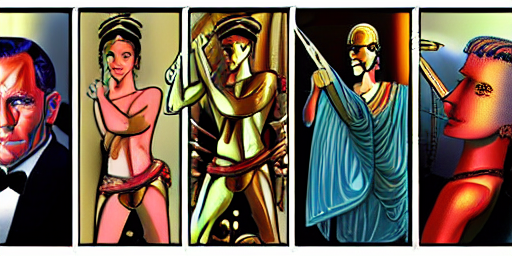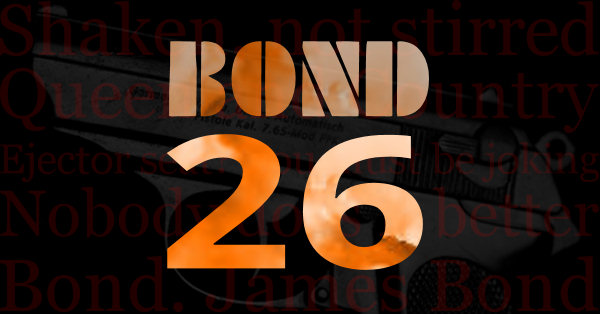Was the most recent Bond film influenced by Greek mythology? Darryl Marsch presents a strong case that it did.

Nothing epitomizes “epic” more than a James Bond film, except for Greek mythology, which provides the foundation for a great deal of western storytelling. I rewatched No Time to Die, the latest installment of the James Bond film franchise and noticed a number of allusions to Greek mythology. Though Daniel Craig’s final James Bond odyssey differs from Greek mythology in some respects, the allusions in No Time to Die explain the storyline choices like Bond leaving Madeline, Felix Leiter’s death, Bond becoming a father, and Bond’s ultimate demise. Moreover, they make the film even more epic.
001 – Bond, Odysseus and Poseidon
After the film’s chilling opening sequence, which introduces the satanically named villain, Lyutsifer Safin, we find James Bond deeply in love with Madeleine Swann and the couple beginning to build their lives together. The plot twists as Bond is tricked into believing that his love, Dr Swann, is an agent of SPECTRE. A bomb explodes, and Bond encounters a one-eyed SPECTRE mercenary, named Cyclops (note, not all of the Greek mythology allusions are this obvious). Cyclops tells Bond that Swann is the “daughter of SPECTRE.” And after a machine-gun shootout in his Aston Martin DB5, Bond places Swann on a train and vows never to see her again. The once-happy couple is ripped apart, planting the seeds of a husband-wife story similar to the one in Homer’s Iliad.
In the Iliad, the Trojan War separates Odysseus from his wife, Penelope. Having sworn an oath to protect Helen, the Queen of Sparta, Odysseus must leave home to fight the Trojan War to bring her back from Troy. After ten years of war and early into his voyage home, Odysseus angers the sea god Poseidon by blinding his cyclops son. Poseidon commands the seas to redirect Odysseus, causing him to endure a long adventure chronicled in the Odyssey before he can return home to his wife.
After Bond places Swann on the train, he slips into solitary retirement in Jamaica. We rejoin him about five years later as he returns from fishing with a Riffe E-55 spear gun, a nod to Ian Fleming, but possibly also to Poseidon. Bond is about to get called back into action, and he must, like Odysseus, return to fight another war and endure his own odyssey.
Poseidon imagery returns late in the film when the tracker in Bond’s smart blood registers as a trident (the Greek letter “Psi”) on Q’s view screen. The allusion implies that Poseidon has been directing Bond’s course, as the sea god did to Odysseus in the Odyssey. Not coincidentally, the trident is also a patriotic nod to the statue of Britannia, who holds a trident in the opening title sequence.
002 – Swann, Penelope and Helen
Early in No Time to Die, James Bond assures Madeleine Swann while driving near Matera that “we have all the time in the world,” when of course they do not. The line is a bitter call back to On Her Majesty’s Secret Service, where Bond married and tragically lost Tracy Draco to the murderous Ernst Stavro Blofeld. In the new film, Blofeld instead sews mistrust to sabotage the couple’s life together, and they are able to reunite as a couple only briefly in Norway. There, Bond suspects that Swann’s child, Mathilde, is his daughter due in part to her blue eyes. Swann blurts out that “she’s not yours,” but later we learn that of course she is Bond’s daughter.
So why was Swann cagey about Bond’s being the father? Perhaps she was still angry that Bond left or that she wanted to shield her daughter from the dangerous world of spies. The answer is uncertain, but the storyline is an allusion to the question of Penelope’s fidelity to her husband, Odysseus. Penelope had over a hundred suitors who wanted her hand and the throne while Odysseus was away and presumed dead. And apparently, there is a lot of discussion in Classics academia about Penelope’s actuality fidelity to Odysseus. Whether Bond fathered Swann’s child is the way that storyline is expressed in No Time to Die.
It also adds to the tragedy of the film that Bond’s brief time with his daughter is clouded by uncertainty about his biological fatherhood. Despite the uncertainty, Bond nevertheless slips immediately and comfortably into the father role. The film is very much about the meaning of fatherhood, and Bond delivers.
In addition to Penelope, Dr Swann also plays the role of Helen of Troy from Greek mythology. The name Swann is an allusion to the animal form (a swan) taken by Zeus when he fathered Helen with Leda, Queen of Sparta. From the film SPECTRE, we know that Dr Swann is the daughter of Mr White, though she does not share his surname and that remains unexplained. Cyclops’s statement that Dr Swann is the “daughter of SPECTRE” further plays on questions about her father. Therefore, it ties nicely for the Helen allusion for Dr Swann to be named after the animal form assumed by Zeus, her allegorical father.
In furtherance of the Helen allusion, Safin steals Swann to his island in the disputed waters between Russia and Japan, just as Paris took Helen to Troy, which was the cause of the Trojan War.
003 – Nomi, Calypso (briefly) and the Divine Constant
Nomi, the new 007, first appears in No Time to Die as a kind of Calypso figure, putting on a smooth island accent to charm Bond after she sabotages his old Land Rover. In spy terms, she wants the old 007 “off the board.” She lies to Bond that she is a diver, who has “a thing for old wrecks.”
The disabled Land Rover and shipwreck reference are allusions to the goddess-nymph Calypso who took Odysseus “off the board” for seven years while he was shipwrecked on her island. The Calypso allusion is likely a callback to another diver, Kissy Suzuki, who kept an amnesia-suffering Bond for companionship on her island home in the novel You Only Live Twice.
But, unlike Calypso and Kissy, Nomi wants to be rid of Bond, and she tells him that in no uncertain terms after she strips off her hair piece and reveals herself as the new 007. This is also a great call back to Rosie Carver in the film Live and Let Die, when her wig flips off and Bond identifies her as a CIA Agent.
Later in No Time to Die, Nomi comes to value and respect Bond. She insists without hesitation on helping Bond recover Dr Swann and her daughter. As Nomi and Bond enter Safin’s lair, Naomi’s avatar registers as the Greek letter Phi on Q’s tracking screen. Phi represents the constant in the golden ratio, the divine proportion in mathematics (not mythology). Perhaps, the symbol here is meant to represent the constancy of the 007 mantle that she undertook, and then generously gave back to Bond. The world needs 007 because, to paraphrase Bond’s attempt at downplay, “it’s [not] just a number.” And, quite hopefully, the silver screen in the closing credits promises that “JAMES BOND WILL RETURN” even after his death.
004 – Felix Leiter and Achilles
Finding a cigar butt left as a calling card at his house in Jamaica, Bond searches for his old friend, Felix Leiter, who in a twist on the Greek epic poem, recruits Bond (Odysseus) to help Leiter (Achilles) as a necessary agent to track down Project Heracles and SPECTRE. Leiter explains to Bond the serious rift between MI6 and the CIA. The two agencies are not communicating, which could be an allusion to King Agamemnon’s quarrel with Achilles during the Trojan War. M plays the role of Agamemnon and Leiter, Achilles.
The character symbolism is borne out when Leiter is murdered by Logan Ash, who is a double agent for Safin. The arrow shaft with which Paris slew Achilles was most likely made from the wood of an ash tree. Achilles, himself, had an ash spear, which he inherited from his father. Hence, the wooden Bond villain name: Logan Ash or Log an Ash. Although Leiter did not mirror Achilles exactly (he was not god-like, given to rage, or shot in the heel), the allusion is certainly there. He was an ally to Bond, just as Achilles was to Odysseus.
005 – Blofeld and the Graeae
There is a scene where we see Blofeld, feigning madness in HM Prison Belmarsh. Later, he conducts a SPECTRE conclave with the aid of a bionic eye linked to another eye-camera processed through the SPECTRE meeting by three ghastly figures. The scene is an allusion to the eye of the Graeae, or three grey sisters, from the story of Perseus. The sisters are blind, but share an eye (sometimes depicted as a crystal ball) that gives them the power of prophecy.
006 – Bond, Heracles, Hades, and Cyclops
Project Heracles, the MacGuffin that everyone chases in No Time to Die, is named for the Greek hero, Heracles (known as Hercules in Roman mythology). In No Time to Die, Heracles is a DNA-specific nano-bot poison that can be transmitted by touch or through a liquid.
In Greek mythology, Heracles dies of blood poisoning, partly due to the way he killed the centaur Nessus with arrows dipped in Hydra blood. Because of the centaur’s trickery, Heracles’s wife, Deianira, gives Nessus’s Hydra-blood-stained tunic to Heracles, which poisons him on contact. Being a half-god, Heracles does not die as the flesh peels from his bones. In agony, he builds a funeral pyre and throws himself upon it. Then, Heracles’s god half ascends to Olympus, while his mortal body descends into the Underworld where Odysseus later finds him.
The final portion of No Time to Die largely parallels elements from Odysseus and Heracles. To recover his family (Dr Swann and Mathilde), Bond must travel to Safin’s island, similar to Odysseus’s journey to Troy, but also clearly a descent into Hades similar to that made by Heracles. Safin’s island along with its poison garden is taken from Ian Fleming’s novel You Only Live Twice. Fleming describes the poison garden as a hellish place with boiling mud pits, toxic plants, and piranhas, to name just a few of its deadly attributes.
While on the island Bond again encounters Cyclops, now working for Safin. Bond dispatches Cyclops by using an electromagnetic-pulse (EMP) device installed in Bond’s watch. The EMP explodes Cyclops’s bionic eye. In the Odyssey, Odysseus does not have an Omega Seamaster upgraded by Q Branch, so he used a less-stylish, sharp stick to blind his cyclops (Polyphemus, who was the son of Poseidon).
After saving his family, Bond returns to Safin’s lair to end project Heracles. There, Safin infects Bond with Heracles-laced blood keyed to his family’s DNA. In allusion to Heracles, Bond calls in the air strike that will destroy Heracles and himself. In this way, Bond’s death becomes similar to Heracles’s own, both infected with poisoned blood and burned on a funeral pyre of their own making.
007 – Heracles, Atlas and Bond
The ship providing the air strike is the HMS Dragon, a real ship (Type 45 destroyer class), but it is also an allusion to the eleventh labor of Heracles. In that myth, Heracles had to slay the dragon Ladon to retrieve magical golden apples. The golden apples bestow immortality or “all the time in the world,” which Bond tells Swann she has at the film’s end. (Recall that while in Norway, Bond served apple slices to Mathilde, when hard-core literary Bond fans would have expected him to make her scrambled eggs). Heracles never ate the immortality-giving apples, himself, just as Bond cannot enjoy “all the time in the world” with his family.
In some versions of the golden apples myth, Heracles trades places with Atlas, holding up the world, while Atlas retrieves the golden apples. This of course is also Bond’s labor and sacrifice, to save the world and hold it up against those who would tear it down.
Conclusion
James Bond is the modern equivalent to a mythological Greek hero, and therefore, I think that the allusions embedded in No Time to Die support the narrative well. Noticing these mythology allusions helped me understand the choices made by the filmmakers and deepened my appreciation for No Time to Die as a heroic epic film.










